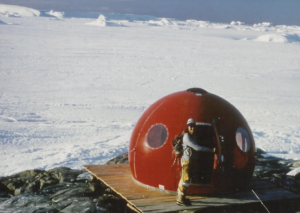This Antarctic igloo was the brainchild of Malcolm Wallhead and are commonly found associated with Antarctic bases and remote field camps. In the 1970’s Malcolm designed an igloo shaped fibreglass hut that was ideal for remote areas but was never put into production.
In 1982 the Australian Antarctic Division (AAD) contacted him about a field shelter that they wanted modified. Malcolm convinced them that his dome design was a better bet and so the first ‘Apple’ was created.
This first one was used for penguin research on Magnetic Island, near Australia’s Davis Base, and is still in use today as a storage hut. This igloo became the first of 63 acquired by the AAD in the following years but they have been ordered by individuals and organisations in places as diverse as Norway, Alaska, Chile, Switzerland, USA, New Zealand and even Papua New Guinea.
They were also used by Greenpeace for the World Park promotion in Antarctica some years back.
Used in Antarctica for everything from mess huts, communication rooms, accommodation, laboratories, non-magnetic instrument rooms and even bathrooms they are a versatile, easily transportable and cost effective component of our Antarctic research.
The huts are light enough to be transported by helicopter or towed behind snowmobiles and can be extended by interlinking them with other igloos. With the help of two or three people an ‘Apple’ can be basically assembled and ready for use within an hour.
They have a diameter of 3 metres, an internal height of 2.15 metres and red is the most popular colour because it can be easily seen in Antarctic conditions but they also come in a range of colours.
Besides their versatility as a shelter an added benefit is that they have a life expectancy of over 20 years in polar areas, emit extremely low Volatile Organic Compounds (VOC) during service and provide safe/inert disposal or recycling of material components when their usefulness has expired.
All up, around 160 igloos have been purchased in 20 countries, in all climatic zones – from polar to tropical and in between- with the majority used in Antarctica.
As a modern interpretation of the classic Inuit shelter this Antarctic igloo is very cute. I haven’t had the opportunity to stay in one yet, but one day. I see them as a modern equivalent to the early explorers huts that provided a warm and memorable shelter from the harsh Antarctic environment.
Photo:The first igloo in Antarctica, assembled on 7 December, 1982.
Image credit: AAD


